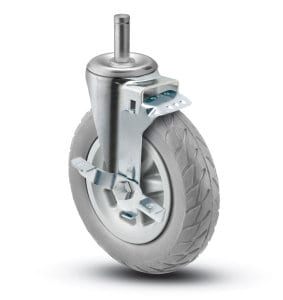 Pneumatic Technology
Pneumatic Technology
Pneumatic is a term that refers to something that is filled with some form of compressed inert gas. There are many different uses and applications of this technology and many uses that are beneficial to various industrial, shipping and mechanical industries. There are many different types of equipment that use a system of compressed air to make certain parts moveable. Similar in usage it hydraulic power, it is a system in which another material is utilized in such a way as to create a greater amount of power in a smaller amount of space.
Specific Usage
There is another use of pneumatic technology that has very specific uses. Casters, the small and often unnoticed wheels on the base of many pieces of equipment are available with pneumatic wheels. Pneumatic casters utilize the pneumatic feature by having air filled wheels. Pneumatic casters are specifically designed for low speed, manual uses. It is important to understand this aspect of pneumatic casters when deciding if they are suited to the job you need to accomplish.
Qualities Specific to Design
Pneumatic casters, due to their design, allow for certain qualities, a more cushioned ride, with quieter operation, and they also offer improved shock absorption over other casters designs and models. One important thing to consider, when deciding if pneumatic casters are the right casters for the job is to look at the importance of the caster height. Pneumatic casters tend to sit a little higher and are purposefully less resistant to surface fluctuations than other types of casters. Therefore, the height of the caster needs to not be a concern.
Benefits of Design
Taking these things into consideration, pneumatic casters with pneumatic wheels can be good choices for certain types of indoor use. They are often found in hospitals, various types of laboratories, including electronic and scientific, department stores hotels and TV or movie studios. In fact, there are many different industries and applications in which pneumatic casters may be useful. For example, pneumatic casters may also be the perfect solution for items and equipment that need to be moved outdoors over potentially rough or uneven terrafin such as grass or gravel. They are able to provide a certain level of stability due to the fact that they are not able to fully sink and therefore they are perfect for items needing to be moved that are very delicate or fragile. Pneumatic casters are also good in areas where certain types of flooring require a certain amount of protection. The wheels, if they are allowed to roll the correct direction, will not leave marks.
Standard and Specialty
Pneumatic casters may be the perfect solution to a specific type of job and set of conditions; however, there are also many other types of casters also available. In fact, there are many options that can be considered when it comes to deciding on the caster that will be best suited to the job at hand. There are standard casters available, and they are divided into three basic categories, Light, Medium and Heavy. The basic casters, although they are available in differing weights, these category divisions refer to the individual load capacities, not to the caster’s individual weight. Based on the design, construction, and material of each individual caster, they have individual load capacity capabilities. There are also other specific characteristics to consider. For example it is important to have in minds details such as how the caster will be attached to the furniture or piece of equipment that it will be used on. Attachment is made possible by the caster’s mounting system. There are basic mounting system options available, including: top plate, threaded stem, stainless steel, expanding adapter stem, square stem, grip ring stem, pipe thread stem, modular stem, top plate swivel, and the kingpinless top plate. Depending on the different mounting system, this will determine how the caster and the items it is attached to interact with one another. Some options allow for more movement, while others allow for less movement between item and caster. Yet another caster attribute to consider is which material the wheel of the caster is made of. Some available wheel material options available, include: performa, performa conductive, polyolefin, polyurethane Hi-Tech, phenolic, cast iron, maxim, and thermo. Each different material serves a different purpose that determines how the caster will function and also how it will interact with its surroundings and the different surfaces that it will be rolling over. It is also beneficial to consider, that besides the many standard options and variations of casters that are available, and the pneumatic casters, there are also other specialty casters available. Some of the specialty options casters that are available include: spring loaded door casters, gravity lock ladder casters, concealed side mount casters, die-cast aluminum leveling casters, rug runner casters, high-capacity, low overall height extrathane casters and glass cutting table casters. Amongst the many different kinds of casters available, there is one that perfectly suited to the job for which you need it.
A Helping Hand
When trying to decide which casters are the best for the job at hand, consider Douglas Equipment. With over fifty years of experience in keeping people and companies moving, we know the right questions to ask to help you to determine the best caster for the job. And with all of the standard and specialty casters available, there is a caster for every job. We take pride in offering consistently excellent customer service, a full-in stock inventory and industry knowledge that is hard to beat. We can help you to determine if a specialty caster is what is needed, or if a standard option is enough to fill your need. Please contact us Toll-free at 1-800-451-0030, locally at 305-888-3700, or by faxing us at 305-883-9563. We can also be reached electronically through the Contact Us section on our website. We are ready to help you determine which casters are the best for you and the job you need to accomplish.




